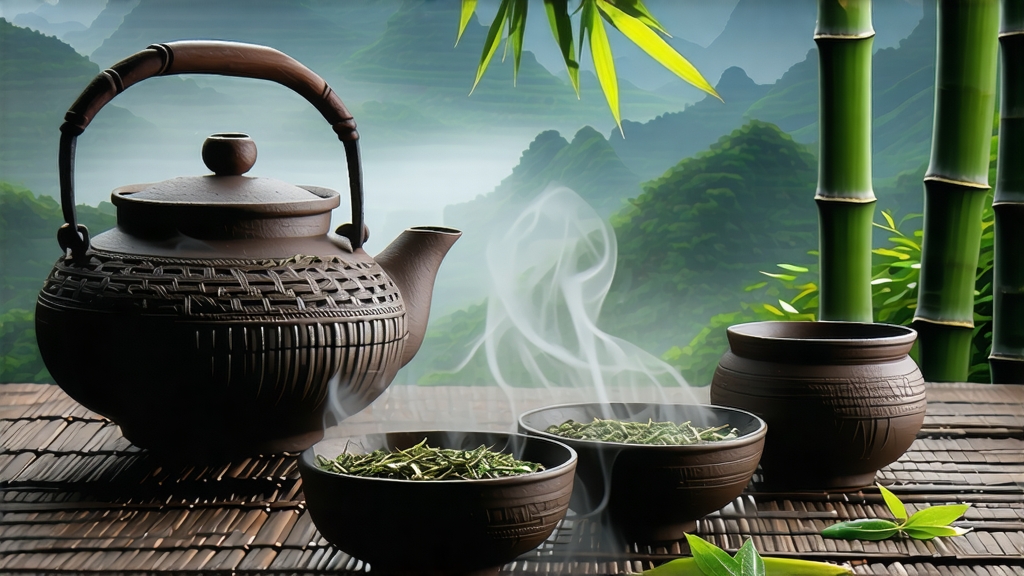
Tucked away in the humid, karst-pocked mountains of southern Guangxi, Liu Bao tea has spent four centuries quietly perfecting the art of transformation. To the casual eye the leaves look almost charred—thick, wiry twists the colour of midnight river stones—yet once they meet hot water they exhale a fragrance that Chinese poets once compared to “old pine after rain, with a whisper of betel-nut.” Internationally Liu Bao remains the least famous of China’s six major tea families, but inside Guangxi teahouses it is hailed as hei cha de lao xiangqin, “the dark cousin who always comes home.” This article invites you to meet that cousin: to understand why porters once carried it along the 6-kilometre ascent to the Nine-Dragon Ridge, how it financed the Maritime Silk Road, and why a single 1980s basket recently sold in Kuala Lumpur for the price of a hatchback.
-
From Border Trade to Imperial Tribute
The story begins in the small county of Cangwu, where the Liu Bao stream joins the Wu River. During the Ming Jiajing era (1522–1566) the imperial court levied tea instead of silver from Guangxi clans; the tea had to survive a 2,000-km journey to Beijing without molding. Local growers discovered that an extra half-day of sun-wilting, followed by a night in bark-lined baskets, produced a tea that arrived aromatic and unspoiled. By the Qing Yongzheng reign the same tea was being compressed into 37-kg baskets, loaded onto bamboo rafts, and floated down to the Pearl River delta where foreign traders exchanged it for Malayan tin and Borneo camphor. Thus Liu Bao became one of the first Chinese teas to circle the South China Sea, predating the better-known pu-erh caravans by almost a century. -
Terroir: Where Rocks Breathe Mist
Liu Bao’s legal appellation is narrower than that of Champagne: only leaves picked within 17 villages of the original Liu Bao stream may bear the name. The soil is a ferric red latosite packed with quartz veins; it drains violently during monsoon yet stays warm in winter, forcing tea roots to dive three metres deep for water. Daytime mountain mists refract sunlight into a soft, bluish spectrum that thickens leaf cuticles, while at night the same mist acts as a thermal blanket. The result is a leaf unusually rich in methyl salicylate, the compound responsible for Liu Bao’s signature cooling, almost medicinal finish. -
Varietals: Beyond the Generic “Camellia sinensis”
Most Liu Bao gardens are planted with a local sub-species called zhong ye zhong (mid-leaf bush). Within that group three clonal selections dominate:- Guilin #4: broad leaves, fast oxidation, prized for young-drinking styles.
- Wuzhou #1: narrow leaves, high polyphenol oxidase activity, ideal for long aging.
- Yulin #3: purple bud mutant, low catechin but high anthocyanin, yields a burgundy liquor and jasmine-like top note.
Farmers often hedge their risk by inter-planting all three at 1.5-metre intervals, creating a biodiversity that discourages pests and gives the master blender more aromatic threads to weave.
-
Craft: The Double Fermentation Dance
Liu Bao is the only Chinese tea that undergoes two separate fermentations, each governed by a different kingdom of microbes.
Stage 1 – Primary Kill-Green & Oxidation
Leaves are spread 4 cm thick on bamboo trays and withered for 6–8 hours until they lose 62 % moisture. A 3-minute 260 °C wok roast (sha qing) deactivates leaf enzymes, but—crucially—the operator leaves the leaf centre at 80 °C, allowing residual oxidases to survive. A 30-minute rolling follows, rupturing 45 % of cell walls without breaking surface wax. The leaf is then piled 50 cm high and covered with wet jute; over the next four hours the core temperature climbs to 55 °C, driving a non-enzymatic browning that turns catechins into theaflavins and thearubigins. This first “yellowing” gives Liu Bao